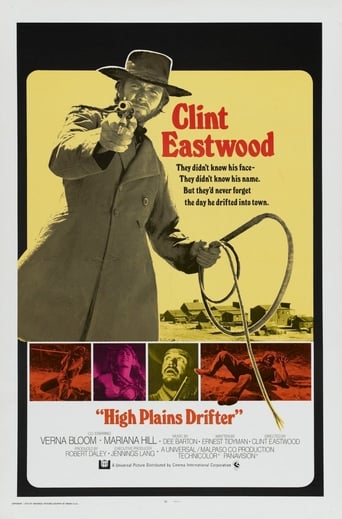
Clint Eastwood has had a unique and special career. He went from a bit Hollywood player, TV actor, Hollywood superstar to, eventually, a well-respected award-winning director. It was during his time in the early 70s as a superstar actor that he started to hone his directing skills. In directing his 2nd feature film, he decided to return to the genre that gave him his greatest success. That being the Western, and “High Plains Drifter” is the result. Eastwood was greatly influenced by the great Sergio Leone, whose westerns contained many spiritual references, but were more allegories than direct religious interpretations. With “High Plains Drifter”, Eastwood gave a more direct influence of the supernatural to his familiar western world.
Eastwood stars as a mysterious, unnamed stranger who rides into the isolated mining town Lago. Lago is run by a mining company, and the company has hired three gunfighters to protect the town. The stranger kills all three with ease when they try to run him out of town, and the town responds by hiring the stranger to replace them. His price in accepting the job was to have a free hand in anything he wanted from the town and its citizens. Apparently, the mining company and the townspeople are worried about the imminent release from prison of three additional gunmen who are serving time due to being framed by the mining company. The fear is that the three, who are hard vicious ruffians, will return to Lago to exact revenge.
This is a very typical straightforward western plot and Eastwood has great fun playing it out. As part of our hero’s getting anything he wants from the town, he makes the town’s abused midget the sheriff, takes over the entire town hotel, buys drinks for the entire town, and paints the town red. The scenes where he struts through the town like an all-powerful king are fun and my favorite parts of the movie. Eastwood, like Leone, enjoyed exposing American Western civilization as being not only cruel but extremely racist. The disdain shown not only to the handicapped midget, but also to the native Americans by the townsfolk shows the Eastwood character’s own cruel actions towards the citizens of Lago as being justified. Throughout the movie it is very clear that this stranger cares very little for the people of Lago.
Eastwood gives written credit to the two directors that influenced him the most. That being Don Segal and Leone. While I did not see too much of Segal’s imprint on the movie, Leone’s is spread throughout the film. The theme of revenge permeates in all of Leone’s movies, as does the use of dreamy flashbacks that hint at the source of the need for revenge. Eastwood does the same in this movie, as our hero keeps dreaming of a lethal beating to death of the ex-sheriff of Lago, by the same three gunfighters who have just left prison and are on their way to Lago. Using a dream music sequence with unfocused visions in this flashback is straight out of Leone’s iconic Westerns. In addition, the opening entrance of the stranger into Lago and his confrontation with the three hired guns is copied straight out of, “A fistful of dollars” (The movie that started Eastwood’s rise to super-stardom). The gunfights have a slow build-up tension that concludes with quick violence, exactly like Leon’s movies (although not close to being as good as in those movies). Also, some of Eastwood’s more stylistic touches in the movie are copied from the Leone movies. The barber shop scene and the bath scene, for example.
Where Eastwood veered away from his influences is what I disliked in the film. I hate writing spoilers but feel the need to explain how this change in film structure rubbed me the wrong way, so if you have not yet seen the movie, you can stop reading now.
The original script, by Ernest Tidyman, had the stranger identified in the end as the brother of the sheriff who was beaten to death. The strangers’ actions throughout the movie make this premise very believable, as he is shown to have true human feelings, from the need for rest, hunger, sex, and everything else that humans require. Eastwood decided to change Tidyman’s ending by making the stranger the vengeful ghost of the dead sheriff and having him vaporize in the horizon. I have no problem making the movie into a western ghost story, but it just did not click with the rest of the movie, as mentioned above. There is nothing within the actions of any of the characters that even hints at this ending. Throughout the movie, the stranger acts like a real person looking for revenge. Making him into a ghost just seems like a cheap add-on made to appear smart. I was not impressed by this ending.
For only his second directorial effort, Clint Eastwood made a fun, entertaining western. It is a shame that he ruined what was a good movie by trying to make it something that it could never become.

